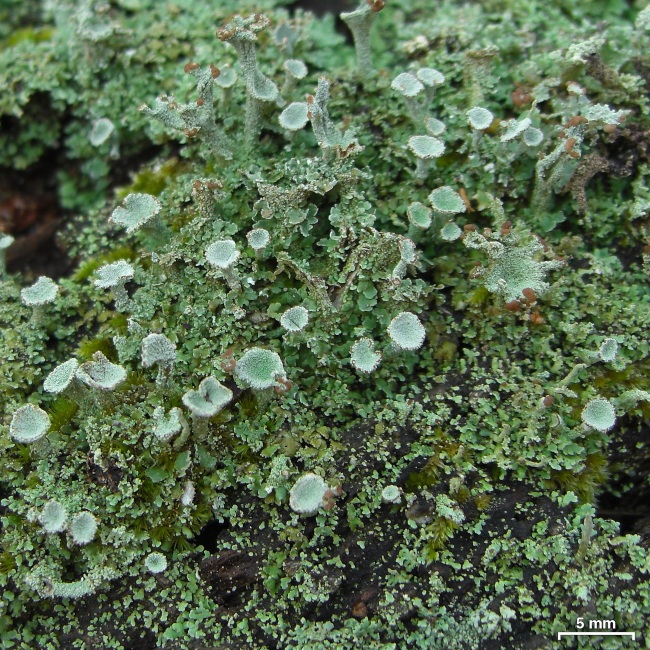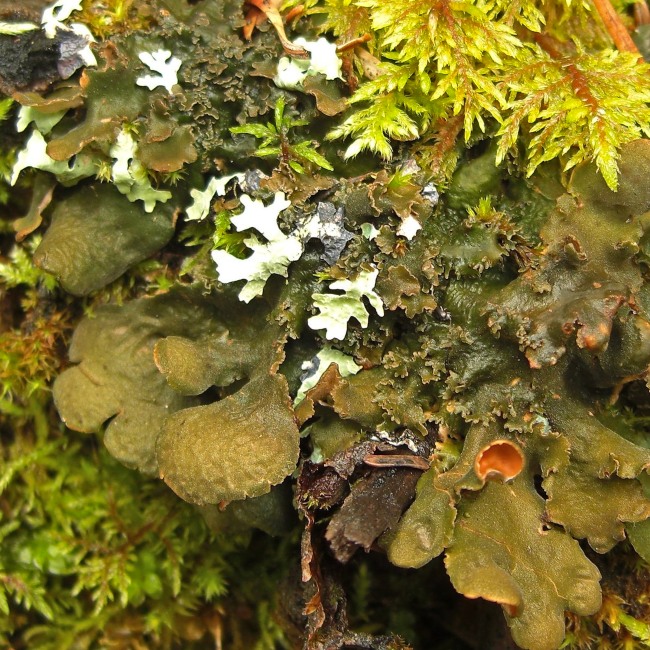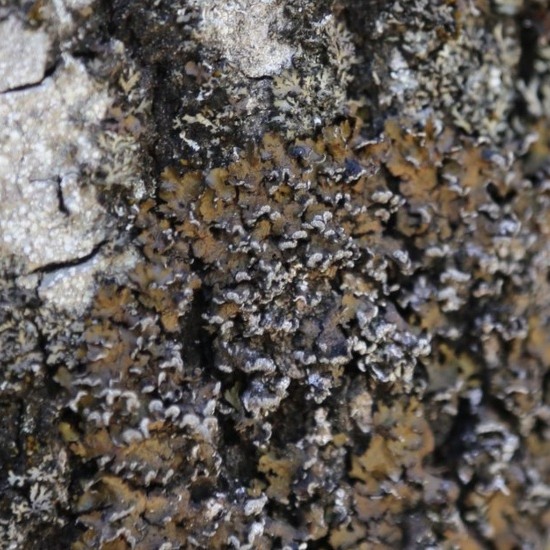Status of Lichen
In this section we explore how human disturbance affects lichen associated with old mixedwood and deciduous forests.
The overall intactness of old-forest lichen species as measured by the Biodiversity Intactness Index was found to be, on average:
93.3%
Northern Operating Area
87.1%
Southern Operating Area
- This means most of the habitat for old-forest lichens is in good condition, but habitat suitability is lower in some areas due to human development activities.
- Habitat suitability is higher in the Northern Operating Area because there is less human footprint in this landbase compared to in the Southern Operating Area.
Introduction
Lichens are plant-like life forms that arise from symbiotic partnerships between at least one fungus and one photosynthetic alga or cyanobacterium[1]. Lichens are an important part of Alberta’s terrestrial ecosystems, including forests in the foothills and boreal forests in Alberta. They provide several functional benefits:
- create habitat for many other species, including within their own "bodies"[2];
- provide food for other species including mammals such as caribou and flying squirrels[3];
- fix atmospheric nitrogen for use by other species[4];
- store carbon and conduct photosynthesis;
- create and stabilize soil; and[5]
- regulate soil moisture and temperature[6].
Lichen diversity responds to forest management, stand age, and stand characteristics with most species being sensitive to forest harvesting[7]. While there are many lichen species that are abundant in coniferous forests, a different community of lichens thrives in old deciduous and mixedwood forests[8], including large, leafy nitrogen-fixing Peltigera (Pelt Lichens), Lobaria (Lung Lichens) and Nephroma (Kidney Lichens) species, as well as one of Alberta’s namesake lichens, Melanelixia albertana (Powdered Camouflage Lichen).
Intactness and sector effects are summarized for lichen species associated with old deciduous and mixedwood forests in Norbord’s operating areas. Details for calculating intactness and sector effects can be found in the Methods.
 Photo: Jason Hollinger
Photo: Jason Hollinger
Gray's Pixie-cup (Cladonia grayi)
Results
Biodiversity Intactness
The overall intactness of old-forest lichen species as measured by the Biodiversity Intactness Index was found to be, on average:
Northern Operating Area
93.3%
26 species
Southern Operating Area
87.1%
26 species
Partner Operating Area
90.5%
26 species
2018 Highlights
- Habitat suitability for old-forest lichen species, as indicated by intactness, is higher in the Northern Operating Area compared to in the Southern and Partner Operating Areas; this can be attributed to the lower amount of human footprint in the north.
- Habitat suitability is predicted to decrease as a result of human footprint for all but one lichen species in all the regions. Poplar Needles (Phaeocalicium populneum) was predicted to be slightly more abundant than expected compared to under reference conditions. This species is associated with mature/old deciduous and mixedwood forests but is also abundant in young harvested stands.
- Four species consistently showed the largest deviation from intact reference conditions in all three operating areas: Common Powderhorn (Cladonia coniocraea f. pycnotheliza), Cat Paw (Nephroma bellum), Hooded Ramalina (Ramalina obtusata), and Blister Paw (Nephroma resupinatum)
- Old-forest lichens are disproportionately affected by human footprint because, as of 2018, 46% and 49% of human footprint had occurred in deciduous and mixedwood forest in the Northern and Southern Operating Areas, respectively.

Blister Paw
(Nephroma resupinatum)

Powdered Camouflage Lichen
(Melanelixia albertana)
Results
Sector Effects
Local Scale Sector Effects
Local scale sector effects are used to understand what industrial sectors are most affecting the abundance of lichen species associated with old deciduous/mixedwood forests in Norbord’s operating areas. Changes in species' relative abundance are predicted within each sector’s footprint compared to the reference conditions with no human footprint.
- With few exceptions, all sectors decrease habitat suitability for lichen species associated with old deciduous/mixedwood forests in the three operating areas because these activities impact their preferred habitat.
- Within forestry footprint, most old-forest lichen species are predicted to be less abundant than expected compared to in the habitat it replaces in each operating area. Eleven species were predicted to be at least 50% less abundant in forestry footprint, in the Northern and Southern Operating Areas.
Regional Population Effects
Regional population effects reflect the total expected change for the population of each old-forest lichen species across Norbord’s operating areas due to each sector’s footprint. This incorporates the area of the footprint, the native habitats in the region where the footprint occurs, and the species' response to a particular footprint. The calculation also incorporates the entire landbase of each operating area, large tracts of which have no human footprint (Figure: Regional Sector Effects)
- Regional effects are much less than local scale footprint effects because a great deal of old-forest lichen habitat has not been disturbed by human footprint in the three operating areas.
- For transportation, energy, and urban/industrial footprint, regional population effects of industrial sectors on old-forest lichens were small—ranging from approximately -3.0% to +1.0% for all three operating areas.
- Forestry footprint resulted in the largest predicted changes to suitable habitat for many old-forest lichens—on average -5.1%, -8.4%, and -6.7% in the Northern, Southern, and Partner Operating areas, respectively—because harvesting is the largest footprint type in all regions. Several species are predicted to decrease by at least 10% at the regional scale as a result of forestry footprint in each operating area.
To view species-specific sector effects, use the drop-down menu to select a species of interest.
Northern Operating Area - Local Scale Sector Effects
Figure: Local Scale Sector Effects. Predicted per cent change in species' relative abundance inside areas that have been disturbed by each sector (human footprint type) compared to reference conditions with no human footprint. Local scale sector effects values less than 0% indicate fewer lichens in that type of footprint than in the reference habitat; values greater than 0% indicate more lichens.
Northern Operating Area - Regional Scale Sector Effects
Figure: Regional Sector Effects. Predicted per cent change in the total regional population of lichens, by species, due to the footprints of each industrial sector. Regional sector effect values less than 0% indicate a predicted decrease in the regional population due to a sector's footprint and values greater than 0% indicate a predicted increase. Note that sector effects consider only the direct impact of disturbed areas and do not consider edge effects or other non-footprint effects (e.g., noise, pollution).
Southern Operating Area - Local Scale Sector Effects
Figure: Local Scale Sector Effects. Predicted per cent change in species' relative abundance inside areas that have been disturbed by each sector (human footprint type) compared to reference conditions with no human footprint. Local scale sector effects values less than 0% indicate fewer lichens in that type of footprint than in the reference habitat; values greater than 0% indicate more lichens.
Southern Operating Area - Regional Scale Sector Effects
Figure: Regional Sector Effects. Predicted per cent change in the total regional population of lichens, by species, due to the footprints of each industrial sector. Regional sector effect values less than 0% indicate a predicted decrease in the regional population due to a sector's footprint and values greater than 0% indicate a predicted increase. Note that sector effects consider only the direct impact of disturbed areas and do not consider edge effects or other non-footprint effects (e.g., noise, pollution).
References
Nash, T.H. III. 2010. Lichen biology, 2nd edition reprint. New York, NY, USA: Cambridge University Press.
Muggia, L and M. Grube. 2018. Fungal diversity in lichens: from extremotolerance to interactions with algae. Life 2018, 8, 15. doi:10.3390/life8020015.
Asplund, J. and D.A. Wardle. 2017. How lichens impact on terrestrial community and ecosystem properties. Biological Reviews 92. doi: 10.1111/brv.12305.
Elbert, W., B. Weber, S. Burrows, J. Steinkamp, B. Büdel, M.O. Andreae and U Pöschl. 2012. Contribution of cryptogamic covers to the global cycles of carbon and nitrogen. Nature Geoscience 5: 459-462. DOI: 10.1038/NGEO1486.
van Zuijlen, K., R.E. Roos, K. Klanderud, S.I. Lang, and J. Asplund. 2020. Mat-forming lichens affect microclimate and litter decomposition by different mechanisms. Fungal Ecology 44: 100905.doi.org/10.1016/j.funeco.2019.100905.
Boudreault, C. P. Drapeau, M. Bouchard, M-H. St-Laurent, L. Imbeau, and Y. Bergeron. 2015. Contrasting responses of epiphytic and terricolous lichens to variations in forest characteristics in northern boreal ecosystems. Canadian Journal of Forest Research 45:595-606. dx.doi.org/10.1139/cjfr-2013-0529.
Ellis, C.J. 2012. Lichen epiphyte diversity: a species, community and trait-based review. Perspectives in Plant Ecology, Evolution and Systematics 14(2):131-152.
Huggard, D. (2017). 6.2 Taxa summaries for Chapter 6 – Technical Report. ABMI 10 year review. https://abmi10years.ca/data/ABMI10yearReview-Supplementary-and-Technical-Documents.zip. See also habitat models at https://abmi.ca/home/data-analytics/biobrowser-home.




